
Since WiLS became an independent non-profit in 2013, we have never had a physical shared office space and we have amassed a wealth of knowledge about the tools and strategies for effective remote working. This is a good time to share some of what we’ve learned and make ourselves a resource to you in case you find yourself needing to shift in-person meetings to virtual and manage staff or communicate with colleagues who may be working from home offices.
The Tools
We use a variety of tools to remain productive and sane during the working day. Among the most important is Slack (https://slack.com/), a chat and file-sharing client that allows person-to-person and person-to-channel communication. We think of it as both our shared office and our break room (we have a #watercooler channel for sharing pictures of pets and Taco Bell Quarterly poems). There is a free version!
Since a great deal of our work is done in meetings with other staff, with members, or with partners, we also rely heavily on Zoom (https://zoom.us/), a web conferencing system that allows users to connect over the internet (with or without video) or over the phone. Screen-sharing components are also critical for keeping meetings on task. Looking for something free and quick? Use Free Conference (https://www.freeconference.com/) or FreeBridge (http://www.telejunctions.com/freebridge.cfm) for phone-based conference calls or Google Hangouts (https://hangouts.google.com/) for video-based ones.
We also use a few other cloud-based applications for sharing documents. Google Docs (https://www.google.com/docs/about/) allows real-time shared editing of documents and Google Drive (https://www.google.com/drive/) provides a place for shared, remote access to them. Coda (https://coda.io/docs) is an online project management tool that is flexible enough to allow for multiple document types (text, tables, images, etc.) to work together seamlessly and provides a home base for projects and all the project components to live.
The Tips
Use video in virtual meetings when you can. Don’t forget to stop working. Take breaks and walk around. Talk to yourself or animals when you need to process. Remember, when you’re working from home, you don’t have to wear pants as long as you keep your camera pointed at the right angle. Get an accountability buddy. Don’t forget to talk with colleagues about real life: the weather, your pets, your lunch. Take advantage of the flexibility (but not too much!) and get outside, do laundry, go to your kids’ school concert, exercise, etc. Have pretty set office hours like a “regular” job. Don’t have chocolate chips in the house. Do have plenty of healthy snacks. Get a good set of earbuds, headphones, or a headset. Allow yourself brief glances at the internet (you’d be chatting with colleagues at an office!). Be as clear as possible about boundaries with members of your household, but also be ok with an interruption when they let you know how their day is going. Have a dedicated workspace with minimal distractions. Make a ‘do not disturb’ sign. Create a noise atmosphere you like – music, white noise, silence – and that serves you depending on your needs and mood. Forgive little technology mistakes, like having the permissions wrong on a Google form or unwittingly muting yourself on a conference call. Noise happens: dogs bark, cats have hairballs, doorbells ring, clocks cuckoo. Shoes are optional and socks are cozy so live life!
Do you have tips to share? Use this Google Doc to see the tips below and share your contributions with us and other WiLS members.
The Brain Trust
We have spent six and a half years learning how to be lean and productive from home offices (and public libraries and car dealerships and fast food restaurant parking lots). Have a question or need a recommendation? We are here for you. Let us know at information@wils.org.
